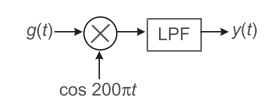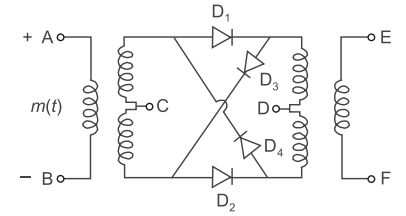Communication miscellaneous
- In an AM signal the received signal power is 10– 10 W with a maximum modulation signal of 5 kHz. The noise spectral density at the receiver input is 10–18 W/Hz. If the noise power is restricted to the message signal bandwidth only, the signal-to-noise ratio at the input to the receiver is—
-
View Hint View Answer Discuss in Forum
Message signal BW fm = 5kHz
Noise power density = 10–18 W/Hz
Total noise power = 10–18 × 5k = 5 × 10–15W
Input signal-to-noise ratio(SNR)i= 10−18 = 2 × 10−4 5 ×10−15
or (SNR)i = 10log10 2 × 104 = 43dB
Hence alternative (A) is the correct choice.Correct Option: A
Message signal BW fm = 5kHz
Noise power density = 10–18 W/Hz
Total noise power = 10–18 × 5k = 5 × 10–15W
Input signal-to-noise ratio(SNR)i= 10−18 = 2 × 10−4 5 ×10−15
or (SNR)i = 10log10 2 × 104 = 43dB
Hence alternative (A) is the correct choice.
- Suppose we wish to transmit the signal x(t) = sin 200 πt + 2 sin 400πt using a modulation that create the signal g(t) = x (t) sin 400 πt. If the product g(t) sin 400 πt is passed through an ideal LPF with cut-off frequency 400π and pass band gain of 2, the signal obtained at the output of the LPF is—
-
View Hint View Answer Discuss in Forum
Given that,
x(t) = sin 200πt + 2 sin 400πt
g(t) = x(t)·sin 400πt
or
g(t) = (sin 200πt + 2 sin 400πt) sin 400πt
If the product say
y(t) = g(t) sin 400 nt
y(t) = g(t)·sin 400πt
= (sin 200πt + 2 sin 400πt) sin2 400πt= (sin 200πt + 2 sin 400πt) (1 − cos 800πt) 2 = 1 (sin 200πt) – sin (200πt) (cos 800πt) + sin (200πt) – sin (400πt) (cos 800πt) 2 = 1 sin (200πt) − 1 [sin (100πt) −sin (900πt)] + sin (400πt) − 1 [sin (1200πt) −sin (400πt)] 2 4 4
If this signal is passed through LPF with frequency 400π and gain 2, the output will be sin (200πt)
Hence alternative (A) is the correct choice.Correct Option: A
Given that,
x(t) = sin 200πt + 2 sin 400πt
g(t) = x(t)·sin 400πt
or
g(t) = (sin 200πt + 2 sin 400πt) sin 400πt
If the product say
y(t) = g(t) sin 400 nt
y(t) = g(t)·sin 400πt
= (sin 200πt + 2 sin 400πt) sin2 400πt= (sin 200πt + 2 sin 400πt) (1 − cos 800πt) 2 = 1 (sin 200πt) – sin (200πt) (cos 800πt) + sin (200πt) – sin (400πt) (cos 800πt) 2 = 1 sin (200πt) − 1 [sin (100πt) −sin (900πt)] + sin (400πt) − 1 [sin (1200πt) −sin (400πt)] 2 4 4
If this signal is passed through LPF with frequency 400π and gain 2, the output will be sin (200πt)
Hence alternative (A) is the correct choice.
- Let x(t) be a signal band-limited to 1 kHz. Amplitude modulation is performed to produce signal g(t) = x(t) sin 2000 πt. A proposed demodulation technique is illustrated in fig. below. The ideal low pass filter has cut-off frequency 1 kHz and pass band gain 2. The y(t) would be—

-
View Hint View Answer Discuss in Forum
Let the output of the modulator is S(t), So
S(t) = g(t)·cos 2000πt
or
S(t) = x(t)·sin 2000πt·cos 2000πt
orS(t) = 1 x(t) sin 4000πt (˙.˙ 2 sin A cos A = sin2A) 2
orS(jω) = 1 {[Xj(ω – 4000π)]} {[Xj (ω + 4000π)]} ...(A) 4j
Since given that x (t) is bandlimited to 1 kHz and from equation (A) we conclude that S (jω) is zero for |ω| ≤ 2000π because ω < 2πfm = 2π 1000. When x1(t) is passed through a LPF with cut-off frequency 2000π the output will be zero.
Hence alternative (D) is the correct choice.Correct Option: D
Let the output of the modulator is S(t), So
S(t) = g(t)·cos 2000πt
or
S(t) = x(t)·sin 2000πt·cos 2000πt
orS(t) = 1 x(t) sin 4000πt (˙.˙ 2 sin A cos A = sin2A) 2
orS(jω) = 1 {[Xj(ω – 4000π)]} {[Xj (ω + 4000π)]} ...(A) 4j
Since given that x (t) is bandlimited to 1 kHz and from equation (A) we conclude that S (jω) is zero for |ω| ≤ 2000π because ω < 2πfm = 2π 1000. When x1(t) is passed through a LPF with cut-off frequency 2000π the output will be zero.
Hence alternative (D) is the correct choice.
- 10 signals, each band-limited to 5 kHz are to be transmitted over a single channel by frequency division multiplexing. If AM-SSB modulation guard band of 1kHz is used then the bandwidth of the multiplexed signal will be—
-
View Hint View Answer Discuss in Forum
The total signal bandwidth 5 × 10 = 50 kHz there will be 9 guard band between 10 signal, so guard bandwidth 9 kHz
Total bandwidth = 50 + 9 = 59 kHz.Correct Option: C
The total signal bandwidth 5 × 10 = 50 kHz there will be 9 guard band between 10 signal, so guard bandwidth 9 kHz
Total bandwidth = 50 + 9 = 59 kHz.
- In the circuit shown below between the terminal A and B an a.c. voltage source of frequency 400 Hz is connected. Another a.c. voltage of 1.0 MHz is connected between C and D. The output between E and F contains components at—

-
View Hint View Answer Discuss in Forum
The given circuit represents ring modulator. In ring modulator the output is proportional to the product of two i.e., m(t) and c(t) → DSB-SC signal
Here, m(t)=Am cos (2π × 400t)
= Am (cos 2π × 0·4 × 103t)
So the output s(t) = m(t )·c(t), contains components at frequency
fc ± fm
or (1000 ± 0·4) kHz or 1000·4 kHz and 999·6 kHz
Hence alternative (D) is the correct choice.Correct Option: D
The given circuit represents ring modulator. In ring modulator the output is proportional to the product of two i.e., m(t) and c(t) → DSB-SC signal
Here, m(t)=Am cos (2π × 400t)
= Am (cos 2π × 0·4 × 103t)
So the output s(t) = m(t )·c(t), contains components at frequency
fc ± fm
or (1000 ± 0·4) kHz or 1000·4 kHz and 999·6 kHz
Hence alternative (D) is the correct choice.

